In the domain of 8-legged creature as brown recluse spider, scarcely any bugs summon as much apprehension and interest as the notorious brown recluse spider, experimentally known as Loxosceles reclusa. These spiders, frequently distinguished by the unmistakable violin-formed checking on their cephalothorax, are a wellspring of interest and worry because of their venomous nibble and potential health implications. In this article, we will explore the universe of brown recluse spider, investigating their propensities, nibbles, side effects, and ways of remaining safe.
Understanding Brown Recluse Spiders
Brown recluse spiders are regularly found in the southern and central US, leaning toward dull, restricted districts like extra spaces, lofts, basements, and stores of wood. Notwithstanding their standing, they are all around introverted normally and conceivably eat when subverted or disturbed.
Brown recluse spiders Bites: What You Need to Know

At the point when these spiders Bites, it infuses toxin that can cause a scope of side effects, from gentle disturbance to serious responses. The actual chomp is frequently easy at first, driving a few people to disregard it until side effects create. It’s fundamental to perceive the indications of such spiders chomp and look for clinical consideration immediately in the event that one happens.
Symptoms of Brown Recluse Spider Bites
The side effects of such spider bite can differ contingent upon variables, for example, the singular’s aversion to the toxin and the sum infused.
Normal side effects include:
- Redness and Swelling: The bite site might become red, enlarged, and delicate soon after the nibble happens.
- Pain and Itching: As the toxin spreads, the impacted region might become agonizing and irritated.
- Blister Formation: at times, a rankle may create at the site of the bite.
- Necrosis: Serious nibbles can prompt tissue putrefaction, where the skin and basic tissue start to pass on. This can bring about a profound, ulcerating wound that requires weeks or even a long time to recuperate.
- Systemic Symptoms: In uncommon cases, foundational side effects like fever, chills, sickness, and body throbs might happen.
Treatment and The executives
If you suspect you’ve been nibbled by such spider, it’s fundamental to search for clinical thought speedily. While most gritty hued recluse bug snack repair in isolation with time, serious cases could require clinical mediation,counting:
- Wound Care: Authentic injury care is principal to prevent pollution and advance recovering. This could integrate cleaning the injury with chemical and water, applying hostile to microbial demulcent, and covering it with a cloth.
- Torment The executives: Over-the-counter pain relievers, for instance, ibuprofen or acetaminophen can help with easing up anxiety.
- Clinical Assessment: In outrageous cases, especially those including tissue debasement or major secondary effects, a clinical consideration provider could prescribe serums poisons or various treatments to prevent tainting and manage aftereffects.
Preventing brown recluse spider
While it’s hard to shed all bet of encountering such spider, there are steps you can take to diminish the likelihood of being snacked:
- Keep Your Home Clean and Clutter-Free: Routinely perfect and clean up your home to dispense with potential concealing spots for insects.
- Seal Cracks and Gaps: Seal breaks and holes in walls, floors, and establishments to keep bugs from entering your home.
- Shake Out Clothing and Bedding: Prior to getting into apparel or bedding that has been put away for a lengthy period, shake it out to unstick any bugs or different vermin.
- Use Caution in Outdoor Spaces: While working in outside spaces, wear gloves and long sleeves to decrease the gamble of experiencing bugs.
Additional Insights on Brown Recluse Spiders
1. Living space and Behavior
Such spiders are nighttime animals, liking to chase and mate during the evening. They are known for their mysterious nature, frequently concealing in dim, undisturbed regions like storerooms, lofts, and cellars. Dissimilar to some other insect species, These spiders don’t turn perplexing networks to get prey. All things being equal, they depend on hunting strategies, ambushing their prey by ready to pounce until a clueless bug meanders into their area.
2. Identifying Brown Recluse Spiders
While the violin-molded checking on the cephalothorax is a typical identifier for such spiders, it’s fundamental for note that this component may not be available or effectively noticeable all the time. Moreover, these spiders have six eyes organized two by two instead of the eight eyes normal for some other bug species. Nonetheless, distinguishing these spiders exclusively founded on actual qualities can be testing, and it’s in every case best to practice alert on the off chance that you suspect you’ve experienced one.
3. Venom Composition and Effects
The toxin of the brown recluse spider contains an intense combination of proteins and poisons that can cause tissue harm and irritation. One of the most unsettling parts of such spider toxin is sphingomyelinase D, a chemical that can separate cell films and lead to corruption, or cell passing. Nonetheless, it’s critical to take note of that not all brown recluse spider chomps bring about necrotic injuries, and the seriousness of the response can change generally from one individual to another.
4. Misidentifications and Misconceptions
Notwithstanding their reputation, brown recluse spider are many times misidentified, prompting pointless frenzy and dread. Many revealed instances of brown recluse spider bites end up being brought about by different arthropods or skin conditions. Furthermore, misinterpretations about the forcefulness and commonness of brown recluse spider add to their outlandish standing as a huge danger to human wellbeing.
5. Geographic Distribution
While these spider are generally ordinarily connected with the southern and focal US, reports of sightings and nibbles have been archived in different locales also. Notwithstanding, their dispersion is restricted by elements like environment and living space reasonableness. In regions where brown recluse spider are common, playing it safe to limit experiences and chomps is particularly significant.
6. Medical Considerations
While looking for clinical treatment for a thought brown recluse spider bite, it’s vital to give exact data to medical services suppliers to guarantee fitting consideration. At times, a finding of an brown recluse spider nibble might be affirmed through clinical perception or research center testing. In any case, treatment essentially centers around overseeing side effects and forestalling auxiliary diseases, as opposed to focusing on the bug toxin straightforwardly.
7. Researchand Protection Efforts
In spite of their fearsome standing, these spiders assume a fundamental part in their environments as hunters of different bugs and vermin. Investigation into their way of behaving, toxin arrangement, and biological collaborations keeps on revealing insight into these mysterious 8-legged creature. Moreover, endeavors to save their regular environments are indispensable for keeping up with sound biological systems and biodiversity.
8. Seasonal Activity
These spiders show occasional varieties in their movement designs. They are generally dynamic during the hotter months, from spring through late-summer, when temperatures are helpful for their endurance and multiplication. During colder periods, brown recluse spiders might turn out to be less dynamic or enter a condition of lethargy to preserve energy. Understanding the occasional vacillations in brown recluse spiders movement can assist people with playing it safe to lessen the gamble of experiences and chomps during busy times.
9. Natural Predators and Threats
While brown recluse spiders are talented trackers by their own doing, they are not insusceptible to predation by different creatures. Different hunters, including birds, rodents, and certain bug species, go after brown recluse spiders and assist with managing their populaces in nature.
Also, natural factors, for example, territory obliteration, pesticide use, and environmental change present dangers to brown recluse spiders populaces, featuring the interconnectedness of biological systems and the significance of preservation endeavors to safeguard these entrancing 8-legged creature.
10. Social Variations
Brown recluse spiders have developed a set-up of conduct variations to improve their endurance and regenerative achievement. Their clandestine nature and obscure tinge assist them with keeping away from identification by hunters and prey the same.
Furthermore, female Brown recluse spiders display maternal consideration ways of behaving, for example, monitoring their egg sacs and youthful posterity, to guarantee their descendants’ endurance.
These conduct variations mirror the mind boggling exchange between hereditary qualities, climate, and regular determination in forming the science of Brown recluse spiders.
11. Metropolitan Legends and Folklore
The brown recluse spider has turned into the subject of various metropolitan legends and fantasies, propagated by sensationalized media inclusion and episodic records. Stories of tissue eating bugs and grim necrotic injuries ascribed to brown recluse spider have added to their criticism in mainstream society.
Notwithstanding, logical proof recommends that such outrageous results are uncommon, and by far most of brown recluse spider nibbles result in gentle to direct side effects that purpose without long haul entanglements.
Isolating truth from fiction is fundamental for scattering unwarranted feelings of dread and cultivating a more nuanced comprehension of brown recluse spider and their job in the normal world.
12. Public Health Considerations
While brown recluse spider chomps can cause critical distress and limited tissue harm, they are seldom perilous, particularly with brief clinical treatment.
Notwithstanding, general wellbeing drives pointed toward bringing issues to light about brown recluse spider and advancing nibble avoidance methodologies can assist with moderating superfluous frenzy and decrease the weight on medical care frameworks.
By instructing the general population about the signs and side effects of brown recluse spider chomps and empowering fitting emergency treatment measures and clinical consideration looking for ways of behaving, general wellbeing specialists can engage people to answer really to possible experiences with these insects.
13. Social Insights and Imagery
In addition to their natural importance, brown recluse spiders hold social importance in different social orders all over the planet. From old stories and folklore to current writing and craftsmanship, these perplexing 8-legged creature have caught the human creative mind and propelled a different exhibit of understandings and portrayals.
Whether respected as images of intelligence and versatility or dreaded as harbingers of risk and noxiousness, In addition to mirror the perplexing exchange between human insights, convictions, and feelings opposite the regular world.
FAQs About Brown Recluse Spiders
Q1: Are brown recluse spiders aggressive?
A: brown recluse spiders are not regularly forceful and will possibly chomp whenever compromised or incited.
Q2: How might it be fitting for me I answer in case I think I’ve been nibbled by an brown recluse spiders?
A: In case you suspect you’ve been chomped by a brown recluse spiders, search for clinical thought immediately.
Q3: Can brown loner insect bite be fatal?
A.Some time brown recluse spiders bites can cause extreme side effects, fatalities are intriguing.
Q4: How might I recognize an brown recluse spiders?
A: brown recluse spiders are normally light to medium brown in variety and have an unmistakable violin-molded checking on their cephalothorax.
Conclusion;
So from all the above information we can say that brown recluse spiderare entrancing animals that, while fit for conveying venomous chomps, are not the malignant hunters they are frequently depicted to be. By grasping their propensities, conduct, and venomous properties, people can exist together with these insects securely and dependably. Training, mindfulness, and regard for these animals and their surroundings are vital to limiting the gamble of nibbles and encouraging a more noteworthy appreciation for the variety of life on our planet.


